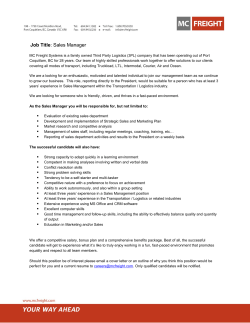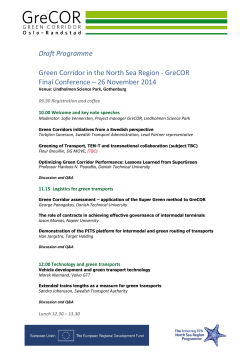
Operational Constraints on Effective Governance of
Research in Transportation Business & Management 14 (2015) 1–3 Contents lists available at ScienceDirect Research in Transportation Business & Management Operational constraints on effective governance of intermodal transport 1. Introduction A significant amount of research on intermodal transport has focused on the role of the public sector in supporting developments through the funding or planning system. This public sector support is based on expected benefits such as emissions and congestion reduction due to modal shift or increased competiveness arising from improved access to major trade links. These expectations are based on ideal scenarios of significant traffic flows, but such scenarios are only likely if the terminals can offer a high quality handling service at low prices to the service operators, who in turn can then offer regular reliable services to shippers and forwarders at prices competitive with road haulage. The relationship between public sector planners and funders and private sector operators is thus of the utmost importance in establishing economically competitive intermodal terminals and services. Public actors find it difficult to tie funding support for intermodal transport development to conditions for the operational model of the terminal or services. This situation raises the risk that such a network may not be operated on a viable economic model capable of supporting a service of sufficient quality to be attractive to shippers and forwarders and thus achieve the desired modal shift. The result can be that services decline and terminals cease operation or require ongoing public subsidy. Research is, therefore, required into the link between the initial funding (both public and private), the business and operational model of the terminal and the services linking terminals, ports, transport operators and customers. This volume aims to address how operational aspects of intermodal terminals and associated services constrain or enable the business models that then allow policy goals to be achieved. For example, government funders want to achieve modal shift by removing barriers such as upfront costs, sunk costs and availability of suitable terminal locations, transport authorities want to provide sufficient capacity and quality of infrastructure for freight operators, regulators want to ensure fair competition and open access to infrastructure and terminals. Research questions to be considered relate to how the practical aspects of the intermodal transport sector constrain or enable these goals, and how public actors can incentivise private operators to work together through investment and planning to further support these goals. A successful business model for a freight facility must encompass public goals on the one side and practical realities on the other, which raises several questions relevant to good governance (Bergqvist & Monios, 2014). How “hands-on” does the public actor need to be to ensure private terminal operators invest in terminals? How can public infrastructure owners ensure that terminal operators provide open access to competitors? How can private terminal operators provide attractive prices to service operators if public actors have demanded overly stringent requirements from them that make investment unattractive http://dx.doi.org/10.1016/j.rtbm.2015.01.001 2210-5395/© 2015 Elsevier Ltd. All rights reserved. or complicated? How can aspects such as equipment management or infrastructure maintenance be specified in contracts given the uncertainties of future business? What is the best way to share responsibilities in a public–private partnership? All of the issues above derive from governance analysis, which seeks to understand how resources, relationships and responsibilities are managed in order to achieve a desired outcome (Monios, 2014). Yet they are very much dependent on the practical realities of the industry. The volume therefore encompasses not only contributions from researchers but also joint contributions from industry representatives and researchers, as a key aim of the volume was to learn about how operational decisions and processes influence and are influenced by the business models adopted by intermodal transport operators. We are pleased to have received many papers with a firm basis in industry practice, while also retaining an academic approach that allows conceptualisation for ease of comparison across spatial and institutional contexts, as well as a deeper theoretical understanding of the larger issues at play in managing intermodal stakeholders. 2. Volume papers The papers in this volume reflect a broad range of interests, from obtaining the best outcome from equipment usage, to stakeholder strategies in inland facility development, to conceptual models and frameworks for increasing the standardisation of knowledge in this sector. The first group of papers focuses on governance and reform issues related to intermodal transport and ports, while the second group examines site development strategies and provides insight into different institutional contexts and related governance issues. The third group of papers addresses the provision of intermodal transport services and explores associated challenges relating to equipment management. The final group of papers concerns frameworks for analysis of stakeholder decisions and terminal concessions. 2.1. Governance and reforms The first group of papers addresses issues of privatisation and reform. Cowie explores the productive efficiency of asset use in the British intermodal market as a result of privatisation, with some comparison to the partial deregulation of the rail sector in the USA. His study of the production economics of British rail freight since privatisation finds few new entrants and a current industry status of apparent stagnation. What this means is that for intermodal growth increased productivity is required as well as a more proactive government policy stance. This paper highlights the need to monitor to what extent current policy and planning regimes are achieving the policy goal of modal shift. 2 J. Monios, R. Bergqvist / Research in Transportation Business & Management 14 (2015) 1–3 Also on the topic of regulation and reform, Chiu and Yen analyse port governance reform in Taiwan. The paper addresses the relationship between port governance and port performance, and the primary operational constraint considered in their research is the role of personnel, a topic that has received little attention in the transport literature. The research also demonstrates that the “organizational life cycle” can be a useful framework for analysing governance reforms. 2.2. Site development Ng et al. examine the role of the public sector in developing new transport infrastructure. Their analysis of public–private partnerships in Canada reflects similar findings in previous research on the importance of understanding the funding mechanisms that are used as instruments of policy. It is often the case that policy goals are pursued by government actors but the operational constraints of the industry can result in unexpected results when the policy is put into practice. Wilmsmeier et al. examine the development of inland intermodal terminals in the context of a developing economy. This paper explores port-hinterland integration in Mexico and compares how similar strategies of the expansion of port dominance into the hinterland are manifested in developing and developed countries. Regulation of the rail industry was found to be one of the major constraints to achieving effective port-hinterland integration. This issue has been resolved to some degree in developed economies with successful intermodal networks (e.g. USA and Europe), but remains a problem preventing developing countries from achieving successful intermodal sectors. Pallme et al. explore a similar issue, comparing four intermodal facility developments in Memphis, USA. From this cross-case analysis, the authors were able to derive some best practice guidelines for such developments, addressing shippers, rail operators and government in a holistic manner. 2.3. Intermodal services Clott et al. address a specific operational aspect of the increasing use of intermodal transport, in this case the increasing trend for the containerisation of bulk commodities. From a current situation where about 5% of the total USA soy crop moves in containers, the authors identify a target of 12–13%, which would not only be economically feasible in its own right, but provide much-needed balance for ocean carriers currently needing to reposition empty containers back to ports due to a lack of export loads. Similarly, Hartman and Clott examine the use of chassis in the USA. This is for the most part a specifically North American issue, as in other parts of the world the chassis or trailer remains with the tractor and it is only the container that moves from actor to actor throughout the intermodal chain. The authors develop a model that allows understanding of trucker and shipper behaviour in chassis provisioning transactions, gives decision makers insight and shows how changes in the basic parameters would influence this behaviour. Hilmola and Henttu focus on border crossings, which is a pertinent aspect of the value of intermodal transport across the world. While the European Union is reducing border control issues over time, many operational constraints exist when trading outside the EU. These issues can be generalised to other parts of the world, areas with long distance corridors and border crossings (e.g. Asia to Europe) or those with many borders, especially affecting landlocked countries that depend on intermodal transport for port access (e.g. Africa). 2.4. Frameworks Like some other papers in the volume, Bergqvist et al. also consider ports, looking at strategies for development of sustainable strategies for hinterland transport. They use multi-actor, multi-criteria analysis to evaluate the criteria considered relevant by all stakeholders. The analysis shows that additional port handling costs and road pricing are the highest motivations to encourage sustainable behaviour, while modal split quotas represent the least preferred option. Monios and Bergqvist identify uncertainties in the contractualisation of intermodal terminal operations, and the paper takes steps towards standardisation of governance models via the use of a port concession framework. While analysis of port governance is increasingly standardised, intermodal terminal governance remains in its infancy. The framework developed in this paper could therefore be of use to public sector administrators managing the concession process, who do not always possess the required industry knowledge to specify such provisions with confidence. 3. Conclusions Several main themes can be derived from the analyses undertaken in the individual papers, all relating to the wider topic of how successful intermodal transport must encompass public goals on the one side and practical realities on the other. One research question addressed was how the practical aspects of the intermodal transport sector (such as equipment usage and border crossing procedures) constrain or enable policy goals of modal shift; findings showed that from the operator's perspective, the provision of intermodal transport services continues to be challenging. Yet the research also revealed that the relevant actors are showing evidence of increasing innovation, finding new solutions that are slowly obtaining efficiency advances that drive greater take-up of intermodal transport and hence modal shift. Another, larger, question tackled was how public actors can incentivise private operators to work together through investment and planning to support new developments and initiatives, including the split of public and private responsibilities and how directly involved public organisations need to be to ensure private operators invest in intermodal transport. The papers demonstrated that site development is complex but best practices are emerging, and some evidence was provided that the understanding of the role of regulation is increasing, particularly with regard to comparisons between developed and developing countries. Relating to this topic is the broader issue of understanding the pros and cons of privatisation, deregulation and other processes of reform for promoting the development and competiveness of intermodal transport, as represented by the two papers addressing this topic. Another emerging theme relates to the need for clear frameworks for action, which was explored in the last group of papers. There is some concern that a lack of sophistication in intermodal terminal contracts leads to uncertainties and discrepancies, producing inefficiency in the transport system. Taking the stakeholder perspective, there is some evidence of positivity towards differentiated dues where the aim is to promote modal shift from road to intermodal based services. These frameworks could be of value not only to industry stakeholders but also to policy and regulatory actors. While many operational constraints on the effective governance of intermodal transport have been identified and analysed in this volume, there are of course many more that could be considered. The goal of intermodal transport is a seamless journey from door to door, but the reality is that it represents the joining together of a number of discrete operations, several stakeholders, numerous legal jurisdictions and a large amount of paperwork. Increasing standardisation has been essential to the development of intermodal transport, not only in the physical standards of containers and handling apparatus, but in domestic and international regulation, in business practice and information sharing, and in supply chain integration through mergers and acquisitions. The underlying goal of this volume has been to present a global spread of issues faced by the industry, to facilitate understanding of the similarities across different contexts. Such understanding is necessary throughout both academia and industry management, in order to work towards a goal of standardisation, both of understanding and of practice. In order to achieve this understanding, further conceptualisations are necessary J. Monios, R. Bergqvist / Research in Transportation Business & Management 14 (2015) 1–3 of the major stakeholders, their motivations and limitations as well as their interactions, but they must be based on the practical realities and constraints of the intermodal industry. The volume editors would like to conclude by thanking the authors for their contributions, the reviewers for their time and thoughtful advice on the papers and the editors of Research in Transportation Business and Management for supporting this volume. References Bergqvist, R., & Monios, J. (2014). The role of contracts in achieving effective governance of intermodal terminals. World Review of Intermodal Transport Research., 5(1), 18–38. Monios, J. (2014). Institutional Challenges to Intermodal Transport and Logistics. London: Ashgate. 3 Jason Monios Transport Research Institute, Edinburgh Napier University, Merchiston Campus, Edinburgh EH10 5DT, United Kingdom Corresponding author. E-mail address: j.monios@napier.ac.uk. Rickard Bergqvist Department of Business Administration, School of Business, Economics and Law, Gothenburg University, P.O. Box 610, SE 405 30 Gothenburg, Sweden E-mail address: rickard.bergqvist@handels.gu.se.
© Copyright 2025









